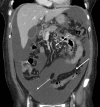Radiology of the Mesentery
- PMID: 35975110
- PMCID: PMC9376046
- DOI: 10.1055/s-0042-1744481
Radiology of the Mesentery
Abstract
The recent description and re-classification of the mesentery as an organ prompted renewed interest in its role in physiological and pathological processes. With an improved understanding of its anatomy, accurately and reliably assessing the mesentery with non-invasive radiological investigation becomes more feasible. Multi-detector computed tomography is the main radiological modality employed to assess the mesentery due to its speed, widespread availability, and diagnostic accuracy. Pathologies affecting the mesentery can be classified as primary or secondary mesenteropathies. Primary mesenteropathies originate in the mesentery and subsequently progress to involve other organ systems (e.g., mesenteric ischemia or mesenteric volvulus). Secondary mesenteropathies describe disease processes that originate elsewhere and progress to involve the mesentery with varying degrees of severity (e.g., lymphoma). The implementation of standardized radiological imaging protocols, nomenclature, and reporting format with regard to the mesentery will be essential in improving the assessment of mesenteric anatomy and various mesenteropathies. In this article, we describe and illustrate the current state of art in respect of the radiological assessment of the mesentery.
Keywords: mesenteropathy; mesentery; organ; peritoneum; radiology.
Thieme. All rights reserved.
Conflict of interest statement
Conflict of Interest None declared.
Figures






References
-
- Gray H. John W. Parker and Son; 1858. Anatomy, Descriptive and Surgical.
Publication types
LinkOut - more resources
Full Text Sources

